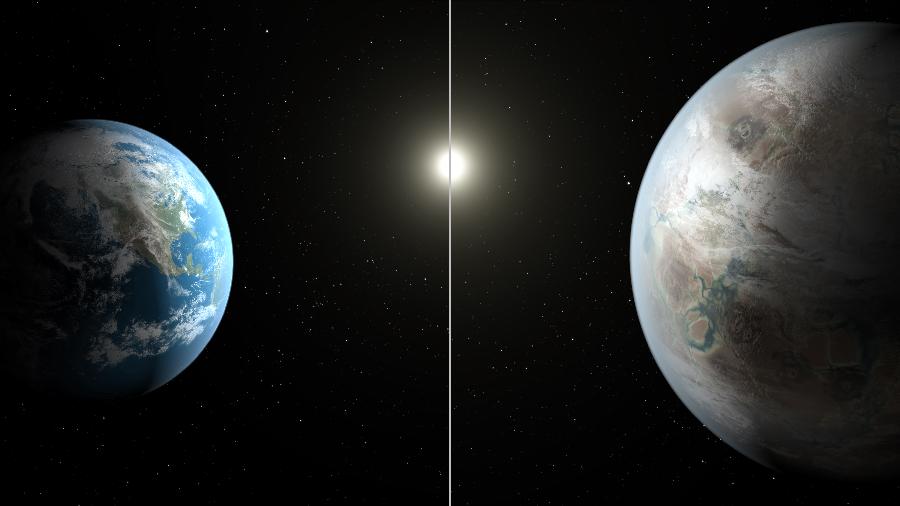


The artistic concept compares Earth (left) to the new planet Kepler-452b. Scientists using planet- hunting Kepler space telescope have discovered a new catalog of exoplanet candidates and confirmed the first near-Earth-size planet in the "habitable zone" around a sun-like star Kepler- 452b, NASA announced during a press conference Thursday. (Xinhua)
BEIJING, July 24 -- The Kepler Mission, which is using a space observatory to discover Earth-like planets orbiting other stars, has confirmed the first near-Earth-size planet in the "habitable zone" around a sun-like star, the U.S. National Aeronautics and Space Administration (NASA) said in press conference Thusday.
"On the 20th anniversary year of the discovery that proved other suns host planets, the Kepler exoplanet explorer has discovered a planet and star which most closely resemble the Earth and our Sun," said John Grunsfeld, associate administrator of NASA's Science Mission Directorate at the agency's headquarters in Washington, "This exciting result brings us one step closer to finding an Earth 2.0."
CLOSEST MATCH OF EARTH EVER FOUND
Though scientists still need more information to determine whether it is another "Earth", meaning whether the planet is rocky like ours or has water and air, it is obviously the most promising one at the moment.
According to NASA, the newly discovered Kepler-452b is a planet circling its parent star Kepler-452, which is located 1,400 light years away in the constellation Cygnus.
Sixty percent bigger in diameter than Earth, the planet is the smallest planet to date discovered orbiting in the habitable zone -- the area around a star where liquid water could pool on the surface of an orbiting planet -- of a G2-type star, like our sun. The confirmation of Kepler-452b brings the total number of confirmed planets to 1,030.
It takes 385 days for Kepler-452b to travel around its parent star, which means a year on the planet is 5 percent longer than that on Earth. And it is 5 percent further from Kepler-452 than Earth is from the Sun.
Kepler-452 is 6 billion years old, 1.5 billion years older than our sun. It has the same temperature of the Sun, but is 20 percent brighter and slightly larger.
"We can think of Kepler-452b as an older, bigger cousin to Earth, providing an opportunity to understand and reflect upon Earth's evolving environment," said Jon Jenkins, scientist from NASA's Ames Research Center, who led the team that discovered Kepler-452b.
"It's awe-inspiring to consider that this planet has spent 6 billion years in the habitable zone of its star; longer than Earth. That's substantial opportunity for life to arise, should all the necessary ingredients and conditions for life exist on this planet," Jenkins said.
The discovery of Kepler-452b is substantial but it is not the first of its kind. Last year, astronomers announced the first Earth-sized exoplanet, Kepler-186f, found orbiting in a star's habitable zone. The main difference between Kepler-186f and Kepler- 452b is their host stars. Kepler-186 is a red dwarf whereas Kepler- 452 is much more similar to our Sun.
STILL A LONG, LONG WAY TO GO
However, the new breakthrough does not mean that humankind has eventually, after years of searching, found another "Earth". In fact, saved its size and its distance from its parent star, nothing is known about Kepler-452b.
Scientists cannot determine what the planet is made of or its temperature. They cannot even decide whether it is a rocky planet like Earth or a gas planet like Jupiter.
In addition, even if Kepler-452b is a rocky planet, the chance of subsistence of life there is still small.
"Its location vis-a-vis its star could mean that it is just entering a runaway greenhouse phase of its climate history," said Doug Caldwell, a SETI Institute scientist working on the Kepler mission, "The increasing energy from its aging sun might be heating the surface and evaporating any oceans. The water vapor would be lost from the planet forever."
However, NASA still believes that this is a milestone moment, saying that "astronomers are on the cusp of finding something people have dreamed about for thousands of years -- another Earth."
"This is really the first step, and humankind's first step", Jenkins said at the press conference, "You and I won't be traveling to these planets, but our children's children's children may."
Launched in 2009, the Kepler spacecraft is NASA's first mission capable of detecting Earth-size planets around stars like our sun. So far, the spacecraft has found 4,696 exoplanet candidates, and follow-up observations and analysis have confirmed the existence of 1,030 of these candidates. Through the combined efforts of Kepler and other astronomers we know of 1,927 exoplanets out there in the cosmos.
Day|Week

 China starts assembly of world’s largest amphibious aircraft
China starts assembly of world’s largest amphibious aircraft PLA's only woman CBRN emergence rescue team
PLA's only woman CBRN emergence rescue team Stunning! Gorgeous girls practice yoga on 2,000-meter-high cliff
Stunning! Gorgeous girls practice yoga on 2,000-meter-high cliff PLA Air Force fighter aircraft in action
PLA Air Force fighter aircraft in action A glimpse of China's Zijinshan gold & copper mine
A glimpse of China's Zijinshan gold & copper mine Be an ageless goddess like them
Be an ageless goddess like them Hot figure show in SW China
Hot figure show in SW China Evolution of Chinese beauties in a century
Evolution of Chinese beauties in a century